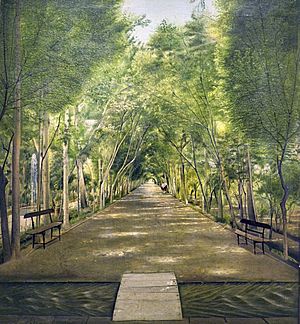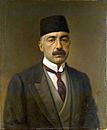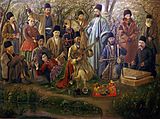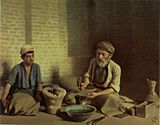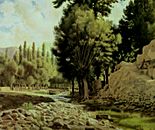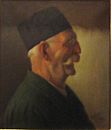Kamal-ol-molk facts for kids
Quick facts for kids
Kamal-ol-Molk
|
|
|---|---|
 |
|
| Born |
Mohammad Ghaffari
September 29, 1848 |
| Died | August 18, 1940 (aged 91) Nishapur, Iran
|
| Resting place | Tomb of Kamal-ol-molk |
| Nationality | Iranian |
| Known for | Painting |
|
Notable work
|
Talar Ayneh |
| Movement | Persian miniature |
| Spouse(s) |
Zahra Khanoom
(m. 1884; |
Mohammad Ghaffari (Persian: محمد غفاری), known as Kamal-ol-Molk (کمالالمُلک), was a famous Iranian painter. He was born into the Ghaffari family in Kashan, a family well-known for its artists.
Contents
Life of Kamal-ol-Molk
Early Life and Artistic Family
Mohammad Ghaffari, later called Kamal-ol-Molk, was born in Kashan in 1848. His family had a long history of being artists. Some of his relatives were famous painters during the time of Nader Shah.
Kamal's uncle, Mirza Abolhassan Khan Ghaffari, was a well-known painter in the 1800s. He was famous for his watercolor portraits. Kamal's father, Mirza Bozorg Ghaffari Kashani, also founded Iran's painting school. His brother, Abutorab Ghaffari, was a talented painter too.
From a young age, Mohammad loved drawing and writing beautifully. He would often draw charcoal pictures on the walls of his room.
Education and Royal Recognition
After finishing his first studies, Mohammad moved to Tehran. He might have learned painting from Mirza Esma'il for a short time. To learn more, he joined the Dar-ul-Funun School. This was a modern school in Persia.
At Dar-ul-Funun, he studied painting with Mozayyen-od-Doleh. This teacher had visited Europe and learned about Western art. Mohammad studied there for three years. During his school days, people started calling him Mirza Mohammad Kashi. He became known as a very talented artist.
Naser al-Din Shah Qajar, the king, visited Dar-ul-Funun. He noticed Mohammad Ghaffari's skill and invited him to work at the royal court. Mohammad improved his painting even more. The king then gave him the special title "Kamal-ol-Molk," which means "Perfection on Land."
Works at the Royal Court
Kamal-ol-Molk stayed at Nasereddin Shah Qajar's court for many years. During this time, he created some of his most important paintings. He painted portraits of important people and beautiful landscapes. He also painted royal camps, hunting areas, and parts of the royal palaces.
This was a very busy time for Kamal-ol-Molk. He painted over 170 pictures. Sadly, many of these paintings are now lost or are in other countries. The works from this period show how much he wanted to improve his oil painting skills. He even learned about perspective on his own and used it in his art. His amazing use of brushes and bright colors made his work stand out.
Travels and New Experiences
Journey to Europe
After Naser al-Din Shah Qajar died, Kamal-ol-Molk found it hard to work for the new king, Mozaffar ad-Din Shah Qajar. So, in 1898, when he was 47, he traveled to Europe. He wanted to make his art even better.
In Europe, he talked with famous artists about their styles and methods. He also copied some paintings by Rembrandt, like "Self Portrait." Kamal-ol-Molk visited many museums in Europe. He carefully studied the works of artists like Raphael and Titian. He even changed some of their works to fit his own style. He stayed in Europe for about four years. In 1902, he came back to Iran. After that, he became the court painter for five different kings.
Time in Iraq
The pressure from Mozaffar ad-Din Shah Qajar's court became too much for Kamal-ol-Molk. He decided to leave Iran and go to Iraq, even though he loved his home country. He visited holy cities in Iraq, which inspired his art during this time. Two of his best paintings from this period are "Karbala-ye-Moalla Square" and "Baghdad Jewish Fortune Tellers."
Later, the Constitutional Movement began in Iran. After two years in Iraq, Kamal-ol-Molk returned to Iran. He joined the Constitutionalists because he disliked Mazaffareddin Shah's government. Paintings like "Commander Asa'd Bakhtiari" and "Azad-ol-Molk" show his work from this time.
Kamal-ol-Molk Art School
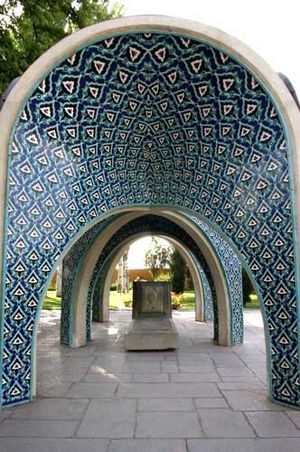
After the Constitutional Movement, there was a new feeling in Persia. The people who supported the Constitution valued art more. Because of this, Kamal-ol-Molk and his work gained more respect.
The master artist started the Sanaye Mostazrafeh Art School. It is better known as the Kamal-ol-Molk Art School. He continued his art career and brought a new style to Iranian art. The school's main goal was to find new talented artists. It aimed to welcome them and teach them in the best way possible.
Kamal-ol-Molk did not just teach painting. He also brought in other arts and crafts. These included carpet weaving, mosaic designing, and woodwork. He wanted to bring back these fine arts that were slowly disappearing. Besides teaching art, he also taught his students about love, good manners, and kindness. He often stayed late at school to teach. He even used some of his own money to help students who were poor.
Later Life and Passing
Kamal-ol-Molk passed away in 1940. He was buried in Nishapur, Iran. His family and close friends walked his body to be buried next to the tomb of the famous Sufi poet, Attar.
Gallery
-
Painting of Naser al-Din Shah Qajar
See also
 In Spanish: Kamal-ol-molk para niños
In Spanish: Kamal-ol-molk para niños
- Islamic art
- Iranian art
- Islamic calligraphy
- List of Iranian artists


